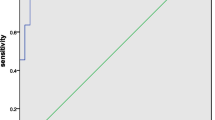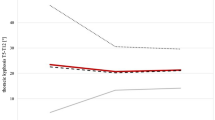Abstract
Purpose
To analyze postoperative changes in the cervical sagittal alignment (CSA) of patients with AIS treated by posteromedial translation.
Methods
49 patients with thoracic AIS underwent posterior arthrodesis with hybrid constructs, combining lumbar pedicle screws and thoracic universal clamps. Posteromedial translation was the main correction technique used. 3D radiological parameters were measured from low-dose biplanar radiographs. CSA was assessed using the C2C6 angle, and the central hip vertical axis (CHVA) was used as a reference axis to evaluate patients’ balance.
Results
Preoperatively, 58 % of patients had thoracic hypokyphosis, and 79 % had a kyphotic CSA. Significant correlation was found (r = 0.45, P = 0.01) between thoracic hypokyphosis and cervical kyphosis. Increase in T4–T12 thoracic kyphosis (average 14.5° ± 10°) was associated with significant decrease in cervical kyphosis in the early postoperative period. The CSA further improved spontaneously during follow-up by 7.6° (P < 0.0001). Significant positive correlation (r = 0.32, P = 0.03) was found between thoracic and cervical improvements. At latest follow-up, 94 % of the patients were normokyphotic and 67 % had a CSA in the physiological range. Sagittal balance of the thoracolumbar spine was not significantly modified postoperatively. However, the procedure significantly changed the position of C2 in regard to the CHVA (C2–CHVA), which reflects headposition (P = 0.012). At last follow-up, the patients sagittal imbalance was not significantly different from the preoperative imbalance (P = 0.34).
Conclusions
Thoracic hypokyphosis and cervical hypolordosis, observed in AIS, can be improved postoperatively, when the posteromedial translation technique is used for correction. The cervical spine remains adaptable in most patients, but the proportion of patients with physiological cervical lordosis at final follow-up remained low (24.5 %).




Similar content being viewed by others
References
Batzdorf U, Batzdorff A (1988) Analysis of cervical spine curvature in patients with cervical spondylosis. Neurosurgery 22:827–836
Edgar MA, Mehta MH (1988) Long-term follow-up of fused and unfused idiopathic scoliosis. J Bone Joint Surg Br 70:712–716
Hwang SW, Samdani AF, Gressot LV, Hubler K, Marks MC, Bastrom TP, Betz RR, Cahill PJ (2012) Effect of direct vertebral body derotation on the sagittal profile in adolescent idiopathic scoliosis. Eur Spine J 21:31–39
Hwang SW, Samdani AF, Tantorski M, Cahill P, Nydick J, Fine A, Betz RR, Antonacci MD (2011) Cervical sagittal plane decompensation after surgery for adolescent idiopathic scoliosis: an effect imparted by postoperative thoracic hypokyphosis. J Neurosurg Spine 15:491–496
Kim YJ, Lenke LG, Bridwell KH, Kim J, Cho SK, Cheh G, Yoon J (2007) Proximal junctional kyphosis in adolescent idiopathic scoliosis after 3 different types of posterior segmental spinal instrumentation and fusions: incidence and risk factor analysis of 410 cases. Spine 32:2731–2738
Weir DC (1975) Roentgenographic signs of cervical injury. Clin Orthop Relat Res 109:9–17
Winter RB, Lonstein JE, Denis F (2007) How much correction is enough? Spine 32:2641–2643
Ofiram E, Garvey TA, Schwender JD, Wroblewski JM, Winter RB (2009) Cervical degenerative changes in idiopathic scoliosis patients who underwent long fusion to the sacrum as adults: incidence, severity, and evolution. J OrthopTraumatol 10:27–30
Moskowitz A, Moe JH, Winter RB, Binner H (1980) Long-term follow-up of scoliosis fusion. J Bone Joint Surg Am 62:364–376
Cochran T, Irstam L, Nachemson A (1983) Long-term anatomic and functional changes in patients with adolescent idiopathic scoliosis treated by Harrington rod fusion. Spine (Phila Pa 1976) 8:576–584
Gore DR, Sepic SB, Gardner GM (1986) Roentgenographic findings of the cervical spine in asymptomatic people. Spine (Phila Pa 1976) 11:521–524
Imrie M, Yaszay B, Bastrom TP, Wenger DR, Newton PO (2011) Adolescent idiopathic scoliosis: should 100 % correction be the goal? J Pediatr Orthop 31:S9–S13
Mladenov KV, Vaeterlein C, Stuecker R (2011) Selective posterior thoracic fusion by means of direct vertebral derotation in adolescent idiopathic scoliosis: effects on the sagittal alignment. Eur Spine J 20:1114–1117
Schmidt C, Liljenqvist U, Lerner T, Schulte TL, Bullmann V (2011) Sagittal balance of thoracic lordoscoliosis: anterior dual rod instrumentation versus posterior pedicle screw fixation. Eur Spine J 20:1118–1126
Ilharreborde B, Even J, Lefevre Y, Fitoussi F, Presedo A, Pennecot GF, Mazda K (2010) Hybrid constructs for tridimensional correction of the thoracic spine in adolescent idiopathic scoliosis: a comparative analysis of Universal Clamps versus hooks. Spine (Phila Pa 1976) 35:306–314
Mazda K, Ilharreborde B, Even J, Lefevre Y, Fitoussi F, Pennecot GF (2009) Efficacy and safety of posteromedial translation for correction of thoracic curves in adolescent idiopathic scoliosis using a new connection to the spine: the Universal Clamp. Eur Spine J 18:158–169
Ilharreborde B, Even J, Lefevre Y, Fitoussi F, Presedo A, Souchet P, Pennecot GF, Mazda K (2008) How to determine the upper level of instrumentation in Lenke types 1 and 2 adolescent idiopathic scoliosis: a prospective study of 132 patients. J Pediatr Orthop 28:733–739
Ilharreborde B, Steffen JS, Nectoux E, Vital JM, Mazda K, Skalli W, Obeid I (2011) Angle measurement reproducibility using EOS three-dimensional reconstructions in adolescent idiopathic scoliosis treated by posterior instrumentation. Spine (Phila Pa 1976) 36:E1306–E1313
Deschenes S, Charron G, Beaudoin G, Labelle H, Dubois J, Miron MC, Parent S (2010) Diagnostic imaging of spinal deformities: reducing patients radiation dose with a new slot-scanning X-ray imager. Spine (Phila Pa 1976) 35:989–994
Despres P, Beaudoin G, Gravel P, de Guise JA (2005) Physical characteristics of a low-dose gas microstrip detector for orthopedic x-ray imaging. Med Phys 32:1193–1204
Canavese F, Turcot K, De Rosa V, de Coulon G, Kaelin A (2011) Cervical spine sagittal alignment variations following posterior spinal fusion and instrumentation for adolescent idiopathic scoliosis. Eur Spine J 20:1141–1148
Hilibrand AS, Tannenbaum DA, Graziano GP, Loder RT, Hensinger RN (1995) The sagittal alignment of the cervical spine in adolescent idiopathic scoliosis. J Pediatr Orthop 15:627–632
Bernhardt M, Bridwell KH (1989) Segmental analysis of the sagittal plane alignment of the normal thoracic and lumbar spines and thoracolumbar junction. Spine (Phila Pa 1976) 14:717–721
Propst-Proctor SL, Bleck EE (1983) Radiographic determination of lordosis and kyphosis in normal and scoliotic children. J Pediatr Orthop 3:344–346
Gille O, Champain N, Benchikh-El-Fegoun A, Vital JM, Skalli W (2007) Reliability of 3D reconstruction of the spine of mild scoliotic patients. Spine (Phila Pa 1976) 32:568–573
Sangole A, Aubin CE, Labelle H, Lenke L, Jackson R, Newton P, Stokes IA (2010) The central hip vertical axis: a reference axis for the scoliosis research society three-dimensional classification of idiopathic scoliosis. Spine (Phila Pa 1976) 35:E530–E534
Lonner BS, Lazar-Antman MA, Sponseller PD, Shah SA, Newton PO, Betz R, Shufflebarger HS (2012) Multivariate analysis of factors associated with kyphosis maintenance in adolescent idiopathic scoliosis. Spine (Phila Pa 1976) 37:1297–1302
Vora V, Crawford A, Babekhir N, Boachie-Adjei O, Lenke L, Peskin M, Charles G, Kim Y (2007) A pedicle screw construct gives an enhanced posterior correction of adolescent idiopathic scoliosis when compared with other constructs: myth or reality. Spine 32:1869–1874
Loder RT, Stasikelis P, Farley FA (2002) Sagittal profiles of the spine in scoliosis associated with an Arnold-Chiari malformation with or without syringomyelia. J Pediatr Orthop 22:483–491
Ghiselli G, Wang JC, Bhatia NN, Hsu WK, Dawson EG (2004) Adjacent segment degeneration in the lumbar spine. J Bone Joint Surg Am A 86:1497–1503
Ilharreborde B, Morel E, Mazda K, Dekutoski MB (2009) Adjacent segment disease after instrumented fusion for idiopathic scoliosis: review of current trends and controversies. J Spinal Disord Tech 22:530–539
Remes V, Helenius I, Schlenzka D, Yrjonen T, Ylikoski M, Poussa M (2004) Cotrel-Dubousset (CD) or universal spine System (USS) instrumentation in adolescent idiopathic scoliosis (AIS): comparison of midterm clinical, functional, and radiologic outcomes. Spine 29:2024–2030
Helliwell PS, Evans PF, Wright V (1994) The straight cervical spine: does it indicate muscle spasm? J Bone Joint Surg Br 76:103–106
Conflict of interest
None.
Author information
Authors and Affiliations
Corresponding author
Rights and permissions
About this article
Cite this article
Ilharreborde, B., Vidal, C., Skalli, W. et al. Sagittal alignment of the cervical spine in adolescent idiopathic scoliosis treated by posteromedial translation. Eur Spine J 22, 330–337 (2013). https://doi.org/10.1007/s00586-012-2493-7
Received:
Revised:
Accepted:
Published:
Issue Date:
DOI: https://doi.org/10.1007/s00586-012-2493-7




